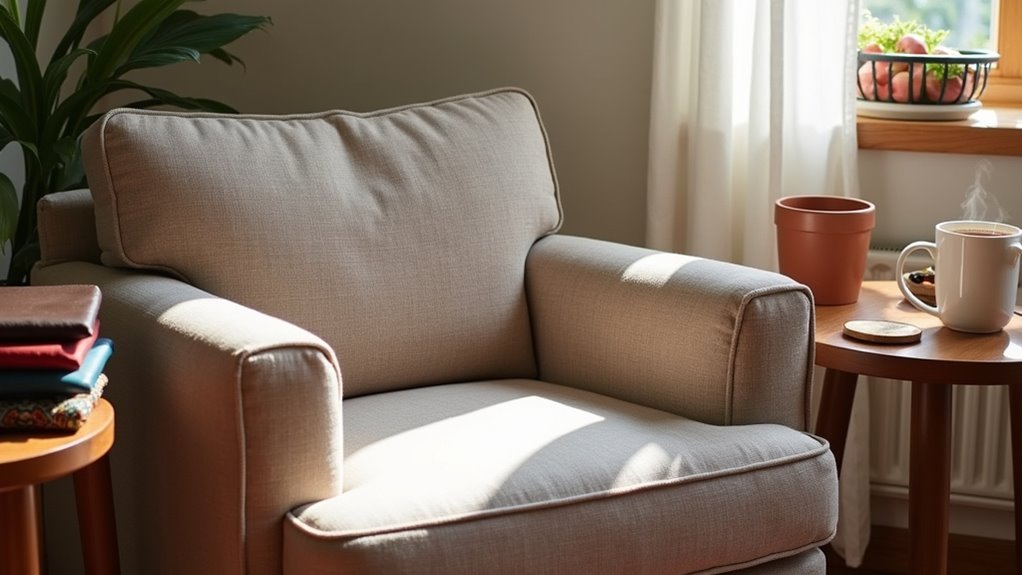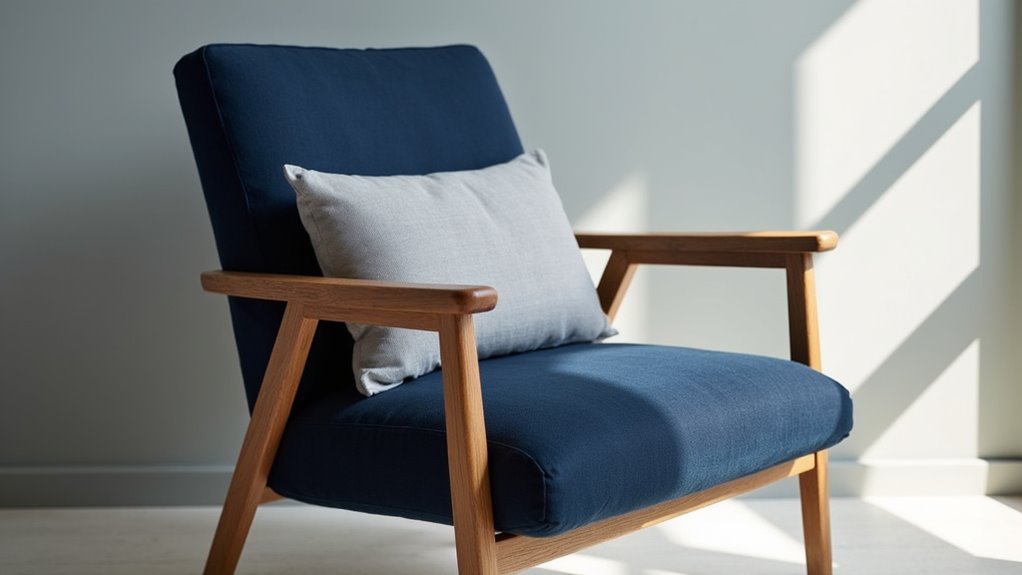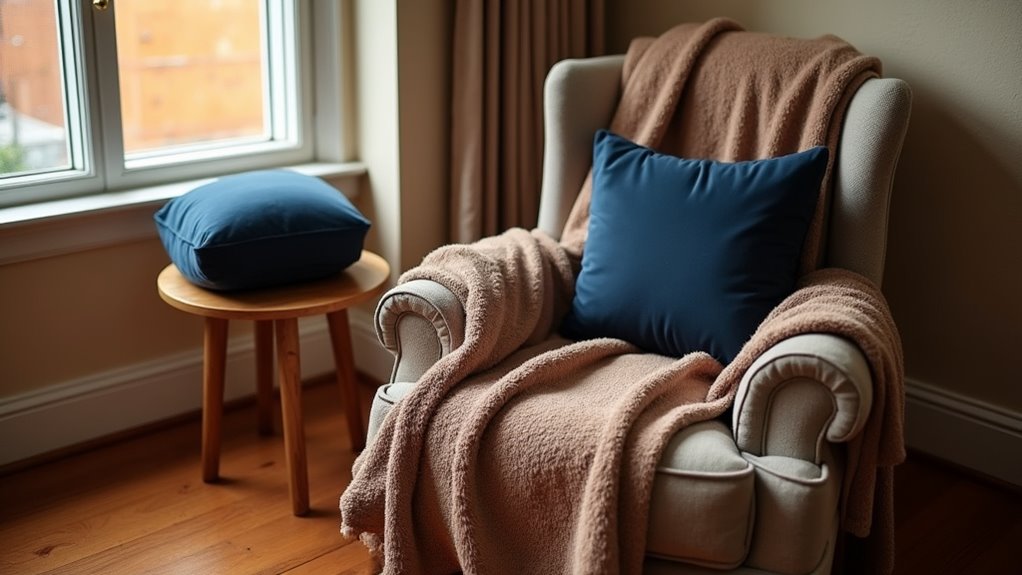How to Make a Chair More Comfortable
This post contains affiliate links. As an Amazon Associate, we earn from qualifying purchases.
To make your chair more comfortable, start by adjusting the seat height so your feet rest flat on the ground, ideally between 15 and 22 inches. Incorporate soft materials like breathable mesh or cozy memory foam for added comfort. Adding cushioning can help relieve pressure points, creating a supportive experience for your backside. Additionally, take advantage of adjustable features like lumbar support and armrests to ensure a perfect fit for your body. Further details and tips will follow for those looking to enhance their chair’s comfort even more.
Essential Facts in 30 Seconds
- Adjust seat height to align with hip height for better posture.
- Use memory foam or gel cushions to relieve pressure points.
- Incorporate adjustable lumbar support for spinal health.
- Regularly clean and maintain the chair for longevity.
- Keep feet flat on the floor and back supported for proper posture.
Assessing Ergonomic Design
Picking a chair with good ergonomic design is very important. Comfort matters, especially during long hours of sitting. Start by checking the seat height. It should adjust between 15.0 inches and 22.25 inches. This size helps the chair fit you well.
Look for adjustable armrests and backrests. These features help you relax and reduce strain. A proper chair selection(ergonomic-chair-selection) can enhance your overall comfort. Additionally, ensuring proper height adjustment of the chair can significantly impact comfort during extended use. Regularly checking chair height can help maintain optimal posture.
Seat depth and width also matter. Aim for a depth of no more than 16.9 inches and a width of at least 18 inches. Rounded edges can prevent annoying pressure points. Support-Arm chairs have been shown to provide lower peak pressures in the buttock-thigh region, enhancing overall comfort.
Breathable materials help keep you cool while sitting. Simple adjustments should be easy to make. Enjoy your time seated. A great chair feels like a cozy hug!
Choosing the Right Seat Surface Materials

Choosing the Right Seat Surface Materials
Picking the right seat surface materials is essential for comfort. Different materials feel different and support your weight in unique ways. Mesh is an excellent choice. It allows air to flow and keeps you cool. Memory foam is another option. It molds to your body and gives great support. This makes it perfect for long sitting periods. Consider that mesh chairs are designed with an open weave that promotes superior airflow, which can significantly enhance your comfort during prolonged sitting. Additionally, a well-chosen lumbar support can further improve your posture and overall comfort while seated. The choice of material can also impact blood circulation, making it crucial to select one that suits your needs. Furthermore, ensuring that your chair height is properly adjusted can also contribute to overall comfort, as it allows for better posture and alleviates strain on your body.
Think about what you need in a chair. Do you want breathability or softness? Your choice can change how you feel while sitting.
A good chair can become your favorite spot to relax. Choose wisely!
Material Types Comparison
The right seat surface materials can change how comfy your chair feels. Let’s explore some great options!
Woven materials offer unique styles. Rush weaving gives a rustic vibe. Paper rope has a classic Danish look. Leather weaving is durable and sleek. Cotton weaving feels soft and cozy. Cane weaving materials are another excellent choice, offering breathability and durability for a long-lasting seat. Additionally, removable covers can make it easier to maintain these materials and keep them looking fresh. Regular cleaning and understanding the material helps to preserve the appearance and comfort of your woven chairs.
For office chairs, leather, either real or faux, looks professional and is easy to clean. Just remember, it can get hot.
Fabric upholstery feels super comfy but might collect dust. Spilled ketchup? A little care keeps it fresh! Regular cleaning can help ensure the longevity of your upholstered chair.
Mesh fabric is breathable and perfect for warm days.
Pick materials that match your style and comfort needs. Your chair will thank you!
Pressure Distribution Importance
Finding the right materials for your chair is crucial. It influences how well your chair spreads your weight. Good pressure distribution leads to less pain and better posture. You can sit comfortably for hours without feeling stiff.
Here are three important tips:
- Foam Elasticity: Choose materials that adjust to your shape. They should relieve pressure in key areas, and soft batting or foam can be a great choice for this purpose.
- Cushion Contour: Pick cushions that follow your body’s curves. This helps avoid discomfort from pressure points.
- Dynamic Support: Select designs that allow movement. This keeps pressure balanced while you sit.
With the right materials, your chair can be a true comfort champion! Additionally, consider adding foam padding to enhance comfort and support, ensuring your chair is both inviting and functional.
Evaluating Comfort Assessment Methods
To find out how comfortable a chair is, mix both feelings and facts. Personal opinions matter. Feelings about the chair show how it fits your body. Use tools like the User-Chair Fit Index. This helps score the best chair for you. A good fit means you can relax without pain. Proper sitting posture is essential to avoid discomfort during long hours of sitting. Additionally, ensure that the chair has adjustable features to accommodate your specific needs for maximum comfort. Remember that correct sitting posture significantly reduces strain on your back, neck, and shoulders. Comfort is key for long hours of sitting. Remember, a chair that feels good helps you focus better. Enjoy your time seated!
Subjective and Objective Measurements
Evaluating the comfort of a chair is essential. Comfort involves both personal feelings and facts.
Here are three effective ways to assess how comfortable a chair is:
- Use comfort rating scales. They help express how you feel about the chair.
- Notice any discomfort in specific body parts. This helps identify problem areas.
- Combine your feedback with measurements. Tools like pressure mapping show how well the chair supports you. Additionally, ensure that the chair provides proper back support to maintain spine alignment and reduce discomfort, as proper sitting position plays a crucial role in overall comfort. A well-designed chair can also promote circulation during long periods of use, enhancing your overall comfort experience.
By using these methods, you can find a chair that feels good and meets your needs.
Comfort matters, so take the time to assess it properly.
Anthropometric Fit Assessment
To ensure your chair fits well, use anthropometric fit assessments. This means measuring how your body aligns with your furniture. Knowing your fit metrics helps you avoid discomfort. Here’s a simple table of important body measurements:
| Body Measurement | Fit Metric |
|---|---|
| Seat Height | Should match hip height |
| Desk Height | Should match elbow height |
| Armrest Width | Should fit snugly under arms |
These measurements keep your chair comfortable and suitable for you. A good fit stops backaches and promotes better posture. Proper sitting techniques can also help maintain spinal alignment and enhance comfort. Make sure to measure before you sit down! Additionally, proper sitting reduces risk of back pain and enhances overall comfort during long periods of sitting. It is also important to adjust the backrest position to support the natural curve of your spine, which can further improve comfort.
Enhancing Cushioning and Padding

To make your chair feel like a cozy cloud, enhance the cushioning and padding!
The right materials and foam layers can change your seating experience. Here are three great options:
- Memory Foam: This type of cushion shapes to your body. It eases pressure points and makes long sitting comfy. Perfect for anyone with back pain!
- Gel-and-Foam Combos: These cushions stay cool while giving support. They do lose firmness over time, so keep that in mind.
- Molded Foam: This option is strong and supportive. It helps you keep good posture and relieves pressure, so you stay comfy for longer.
Additionally, consider reupholstering your chair cushion to further enhance comfort and style. Choose the best option for your comfort! Enjoy your cozy chair!
Implementing Adjustable Features

A comfy chair can make a big difference. Adding adjustable features can improve your sitting experience. You can enjoy better posture and less strain with simple tweaks. Here’s a quick guide to important adjustable features:
| Feature | Benefits | Adjustment Type |
|---|---|---|
| Seat Height | Helps with posture and comfort | Pneumatic lever |
| Lumbar Support | Supports your back | Manual slider or pneumatic |
| Armrests | Reduces shoulder pain | Height and width adjustment |
| Seat Depth | Supports your thighs | Manual slider |
| Tilt Adjustment | Encourages better posture | Tilt tension control |
These adjustments help your chair fit you perfectly. Tweak your chair for maximum comfort. Say goodbye to discomfort. Enjoy your sitting experience!
Maintaining and Upgrading Comfort Elements

Keeping your chair comfy is important. A few simple steps can make a big difference in your sitting experience.
Follow this easy routine to enhance your chair’s comfort:
- Weekly Wipe Down: Use a microfiber cloth to dust your chair. This keeps it looking good and working well.
- Monthly Spot Clean: Choose the right cleaner for your chair’s material. Use upholstery cleaner for fabric or leather conditioner for leather. This helps remove stains quickly.
- Quarterly Deep Clean: Vacuum your chair and clean all parts, including the casters. Regular checks ensure everything stays smooth and comfy.
With these steps, your chair will stay fresh and comfortable for longer.
Frequently Asked Questions
How Often Should I Replace My Office Chair?
Replace your office chair every 5 to 10 years. This depends on how much you use it and its quality. A good chair offers comfort and support. Check your chair often to see if it shows signs of wear. Look for loose parts, broken wheels, or worn-out fabric. These can affect your comfort and posture. Keeping your chair in good shape helps you work better. Don’t ignore it; your daily tasks deserve a reliable chair. Remember, a good chair can improve your focus and productivity.
What Are the Signs of an Uncomfortable Chair?
Sitting in an uncomfortable chair can feel like a nightmare. Signs are clear. You might feel pain in your back or legs. Poor support can make you slouch or feel stiff. Constant fidgeting means your body is trying to find relief.
These signs show it’s time to change your chair. A good chair supports your back and encourages good posture. It should feel comfortable even after long hours of sitting. Don’t ignore discomfort. Find a better chair to improve your comfort and focus.
Can I Use a Regular Chair for Long Hours?
Using a regular chair for long hours is possible. Comfort is key. Consider adding cushions or lumbar supports. These can make a big difference. Proper posture helps reduce body strain. Take breaks often. Stand up, stretch, and walk around. This keeps blood flowing and muscles relaxed.
Many people use regular chairs and feel fine. Yet, some may experience discomfort over time. Listen to your body. If you feel pain, adjust your setup. Small changes can lead to big improvements. Make your workspace comfortable. Enjoy your time sitting!
How Does Posture Affect My Overall Health?
Slouching might seem harmless, but good posture is key to better health. It helps with digestion, making your tummy feel good. Good posture also lifts your mood. You feel happier and more confident.
Proper alignment makes it easier to move. You can walk, sit, and stand without pain. This boosts your energy levels too. Feeling energized helps you tackle daily tasks.
What Are the Best Practices for Sitting Posture?
To have the best sitting posture, focus on a few key points. Keep your feet flat on the floor. Use a chair with good lumbar support. Sit up straight. Relax your shoulders. Take breaks often. Stand up and stretch every hour. This helps reduce strain and keeps you comfortable. Good posture can improve your mood and help you work better. Always remember, small changes make a big difference.
Conclusion
Making your chair more comfortable is easy. Think of it like putting a soft blanket on it. Small changes can make a big difference. Add cushions for extra softness. Adjust the height so your feet touch the ground. You can also use a lumbar support pillow for your back.
Try different features until you find what feels best. Comfort matters. A cozy chair can become your favorite spot at home. Enjoy your new throne of relaxation!
